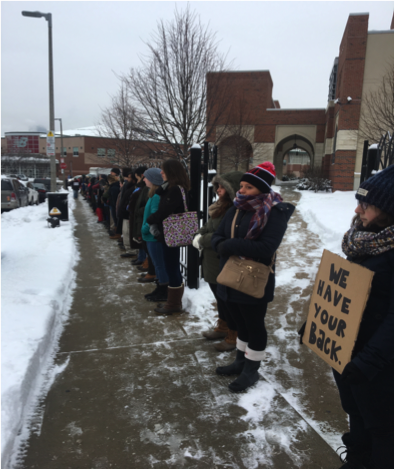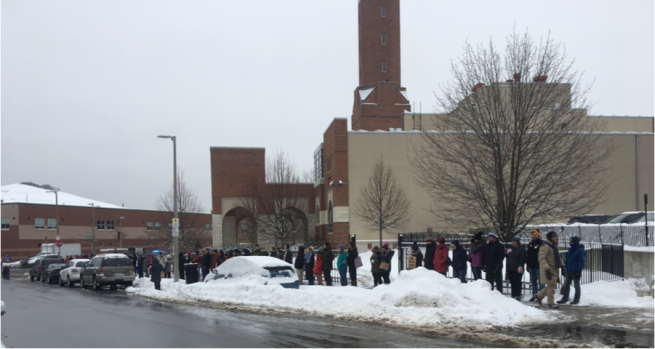A middle-aged woman leans over to ask the elderly man next to her if she could take a look at the program in his lap. The two strangers discuss the play at which they were about to see, their conversation eventually becoming more and more muffled, until it blends in perfectly with the rest of the audience’s faint murmurs.
All at once, the audience falls silent as the lights slowly dim in the Inner Sanctum Studio Boston, where the performers come to life through the play “Incident at Vichy”.
Daniel Boudreau, the founder of Praxis Stage Theater Company, said the play, which is about the rise of Nazis, parallels his feelings about the current political situation and President Donald Trump’s “hateful immigrant bashing”. Praxis Stage was launched in the wake of Trump’s election as a company that would perform strictly political plays.
It is just one of the many ways in which people are expressing their opposition to the president through political art.
Political art in its many forms has been a conventional driving force in the resistance against president Trump and his administration, according to visual artist Sarah Rushford.
“After the inauguration and during the first major protests, I personally knew hundreds of artists involved in protest exhibitions. It is absolutely a time of art making directly about politics,” Rushford said.
Rushford is largely involved in video and text art, where she produces videos or examines the power of language by picking apart certain parts of a text and scribbling different elements, such as graphite over words to emphasize them. Her text artwork, featured in the “Transition of Power: 2017” art exhibit, in the 13FOREST Gallery in Boston, corresponds directly with our current political situation, according to Rushford.
Her work, entitled “Alluvion”, includes a series of drawings made by scratching the text of the U.S. Constitution onto paper and then scribbling with graphite over the words to reveal them, Rushford said.
“I’m doing this as a way for myself to take in the meaning of the fundamental ideas on which my country is built, through my body, by writing by hand. The scratching stylus becomes a tool of urgent communication in a time of great need,” Rushford said.
Northeastern freshman Chané Ghuman attended the “Transition of Power: 2017” event when it first opened. She said the visual texts, the photography, and the art pieces, spoke to her about politics in a way that the media could not.
“It sounds weird, but I felt like the artwork was talking to me. It was an enlightening experience, Ghuman said.
The works in the exhibit influenced not only the viewers, but also the artists themselves, according to Rushford. As Rushford strolled through the exhibit, viewing her own art as well as the works of others, she said she remembered smiling and thinking of how beautiful it was for artists to unite together against such a strong and hateful force.
“For me this exhibition was important because it showed me that making art in reaction to Donald Trump is a real and effective way of protesting,” Rushford said.
Asia Kepka, a visual photographer whose work was also featured in the “Transition of Power: 2017” art exhibit, discusses the importance of political art and shares with us some of her experiences as a political artist during the Trump era.
“When I found out that Trump would be our next president, I was in mourning. The sadness and disbelief I felt was overwhelming,” Kepka said. “The period after the election brought me back to memories of funeral processions in my home country of Poland, where black flags would blow in the wind, letting the whole world know a tragedy had happened”.
Kepka said that as an artist, she felt as if she had an obligation to make art that expressed not only her feelings, but also the feelings of others who may not be able to express their opinions in a visual way.
Northeastern freshman Josie Cerbone said that she thinks it is amazing that there are so many political artists willing to share what they believe in and represent the beliefs of so many others through their art.
“Art during the Trump Era is definitely a valuable tool for so many people who can’t create or share their feelings. It is nice to know that people can still see some of their opinions being represented through the works of others,” Cerbone said.
Kepka’s collection of black and white photographs, which were presented in the “Transition of Power: 2017” exhibit reflect the overall dark and dismal reality of Trump being the current president, Kepka said.
The artist’s house is featured in one of the photographs. In the photo, long, black, strips of fabric hang from the windows of her house. Kepka said that the black fabric hanging from her windows symbolized the black flags that were present at funeral processions in Poland.
“My house was going to become an outlet for my crying soul,” Kepka said.
Although she was the only Polish person on her street, Kepka said that she was getting reactions about her house from many people in her neighborhood.
“The new look of my house resonated with people from different walks of life, people from all over the world. I was told that seeing my house in mourning expressed exactly how they were feeling,” she said.
Being from Poland, Kepka said that she is well aware of the importance of political art. She said that art has the power to save nations and that it is vital now more than ever to remind American citizens of the value of political art.
“My country did not exist for more than 100 years during Russian, German, and Austrian occupation. My nation survived because of the art that was created by painters, poets, writers, and musicians,” Kepka said. “Art gives people a sense of pride during difficult times. Art is a weapon in speaking out against injustice”.



